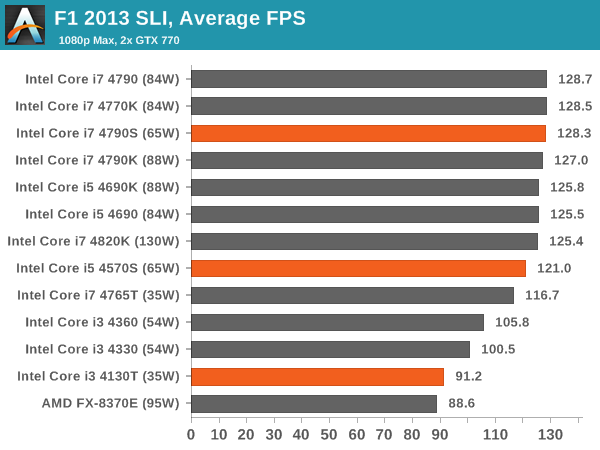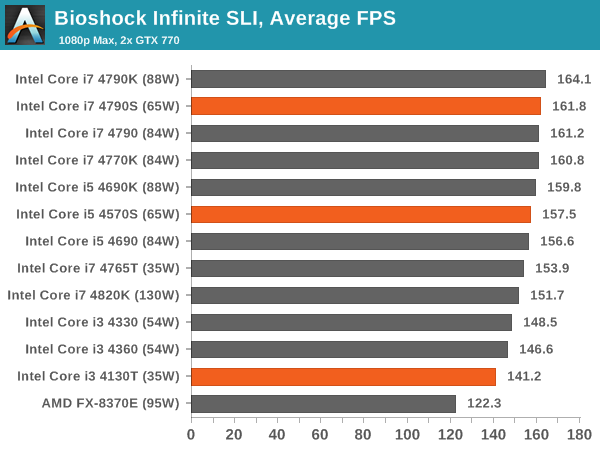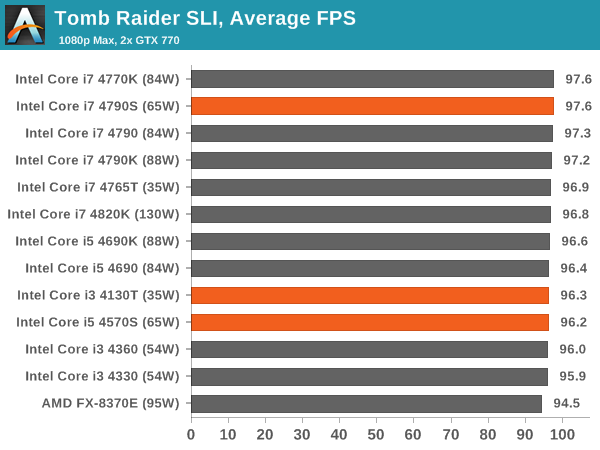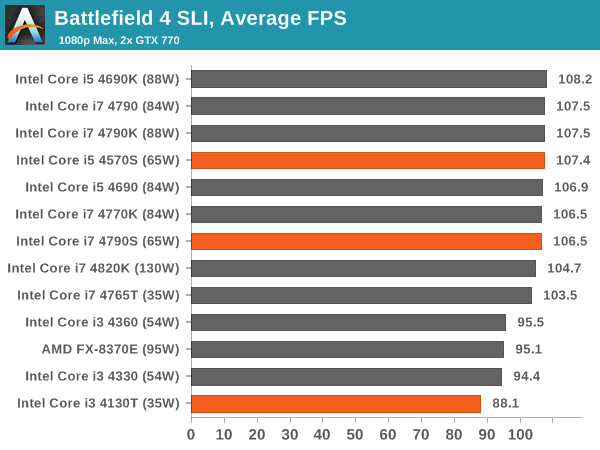Intel Haswell Low Power CPU Review: Core i3-4130T, i5-4570S and i7-4790S Tested
by Ian Cutress on December 11, 2014 10:00 AM ESTGaming Benchmarks on GTX 770
F1 2013
First up is F1 2013 by Codemasters. I am a big Formula 1 fan in my spare time, and nothing makes me happier than carving up the field in a Caterham, waving to the Red Bulls as I drive by (because I play on easy and take shortcuts). F1 2013 uses the EGO Engine, and like other Codemasters games ends up being very playable on old hardware quite easily. In order to beef up the benchmark a bit, we devised the following scenario for the benchmark mode: one lap of Spa-Francorchamps in the heavy wet, the benchmark follows Jenson Button in the McLaren who starts on the grid in 22nd place, with the field made up of 11 Williams cars, 5 Marussia and 5 Caterham in that order. This puts emphasis on the CPU to handle the AI in the wet, and allows for a good amount of overtaking during the automated benchmark. We test at 1920x1080 on Ultra graphical settings.

Bioshock Infinite
Bioshock Infinite was Zero Punctuation’s Game of the Year for 2013, uses the Unreal Engine 3, and is designed to scale with both cores and graphical prowess. We test the benchmark using the Adrenaline benchmark tool and the Xtreme (1920x1080, Maximum) performance setting, noting down the average frame rates and the minimum frame rates.

Tomb Raider
The next benchmark in our test is Tomb Raider. Tomb Raider is an AMD optimized game, lauded for its use of TressFX creating dynamic hair to increase the immersion in game. Tomb Raider uses a modified version of the Crystal Engine, and enjoys raw horsepower. We test the benchmark using the Adrenaline benchmark tool and the Xtreme (1920x1080, Maximum) performance setting, noting down the average frame rates and the minimum frame rates.

Sleeping Dogs
Sleeping Dogs is a benchmarking wet dream – a highly complex benchmark that can bring the toughest setup and high resolutions down into single figures. Having an extreme SSAO setting can do that, but at the right settings Sleeping Dogs is highly playable and enjoyable. We run the basic benchmark program laid out in the Adrenaline benchmark tool, and the Xtreme (1920x1080, Maximum) performance setting, noting down the average frame rates and the minimum frame rates.

Battlefield 4
The EA/DICE series that has taken countless hours of my life away is back for another iteration, using the Frostbite 3 engine. AMD is also piling its resources into BF4 with the new Mantle API for developers, designed to cut the time required for the CPU to dispatch commands to the graphical sub-system. For our test we use the in-game benchmarking tools and record the frame time for the first ~70 seconds of the Tashgar single player mission, which is an on-rails generation of and rendering of objects and textures. We test at 1920x1080 at Ultra settings.
















76 Comments
View All Comments
eanazag - Thursday, December 11, 2014 - link
That would directed at Ryan Smith and maybe jarred Walton for the mobile side of the equation. I suspect that the mobile side is unaffected at the moment.The only card that is well supported by all the new features in Omega is the R9 285 (Tonga). The R9 290 and 290X make a decent showing but are missing the 4K virtual resolution support.
chekk - Thursday, December 11, 2014 - link
Based on some other reviews, I was starting to think Anandtech had switched back to separate power consumption idle and load numbers, but here we go again. Please stop.The audience here is enthusiasts and enthusiasts want the complete picture.
DiHydro - Thursday, December 11, 2014 - link
I agree, if I have a server that is idle most of it's life, I want to know how many watts it is drawing at idle. On the other hand, if it is running 100% 24/7 then I want to see if a higher TDP, better performing CPU will be cost effective over a cheaper lower TDP part that might run a task longer.alacard - Thursday, December 11, 2014 - link
Xbitlabs did an excellent write up on the 4670S and T variants. Idle results for those can be found here: http://www.xbitlabs.com/articles/cpu/display/core-...Ultimately extremely disappointing results. Intel couldn't even be bothered to do the bare minimun and bin these chips for better perf/watt. Pathetic.
TiGr1982 - Thursday, December 11, 2014 - link
Captain Obvious tells us all, that Intel has a very weak competition on the x86 CPU front in all the recent years (I would say, right from the launch of Sandy Bridge LGA1155 almost 4 years ago). So, they make big money "for free" (in a sense that it's an easy money for them) all these years and don't have to bother about such peculiarities as better perf/watt...Khenglish - Thursday, December 11, 2014 - link
That xbitlabs review is very good and what I would have liked to see done here.Yeah bad results. I was hoping that these new parts meant that intel improved haswell's power efficiency, but in reality they just lowered the TDP.
smilingcrow - Thursday, December 11, 2014 - link
This feels like almost a completely wasted review, a sort of Seinfeld review; a review about nothing.Most things you can surmise about these S chips as many things scale linearly so it would have been good to have seen a much better focus on power consumption.
The unanswered question is whether these chips use different voltages than the stock chips and also a lack of hard power data; the delta data is not enough.
Also what did you use to load the cores?
It says AVX but what application and is AVX a good example to use as how many applications use it?
I’d like to have seen a focus on different CPU loads to determine the different characteristics of these S chips; INT, FP, AVX.
So rather than the multitude of redundant data that can deduced from scaling of frequency why not something focused and new!
What a wasted opportunity and a poorly thought out review.
theKai007 - Thursday, December 11, 2014 - link
Intel announced the Intel IoT Platform, a reference model end-to-end designed to unify ans simplify connectivity and security for the Internet of Things. http://bit.ly/1yCMSnBname99 - Thursday, December 11, 2014 - link
Look at the partners.Looks more like a enterprise software "solution" to acquire/store/extract data from than actual hardware or anything of interest to normal folks.
As long as Intel's HW story in that space is Quark, forget it...
xeizo - Thursday, December 11, 2014 - link
Right on spot, I use a 4570S in my Linux home server. But as an enthusiast I did some bclk(couldn't resist it) to 106.4 so that it Turbo:s to 3.83GHz and multithreadsx4 to 3.4GHz ;-) Anyway, it feels very fast running Linux. I couldn't have used a K-processor as I wouldn't be able to resist maximum clock it, no power saving server ...Gaming is done on a 4.8GHz 2600K, it doesn't look like a need to replace it anytime soon. Unless Skylake surprises us all.
Nice job informing about those lower power cpus, saves us time from undervolting and just draws less power from day one.